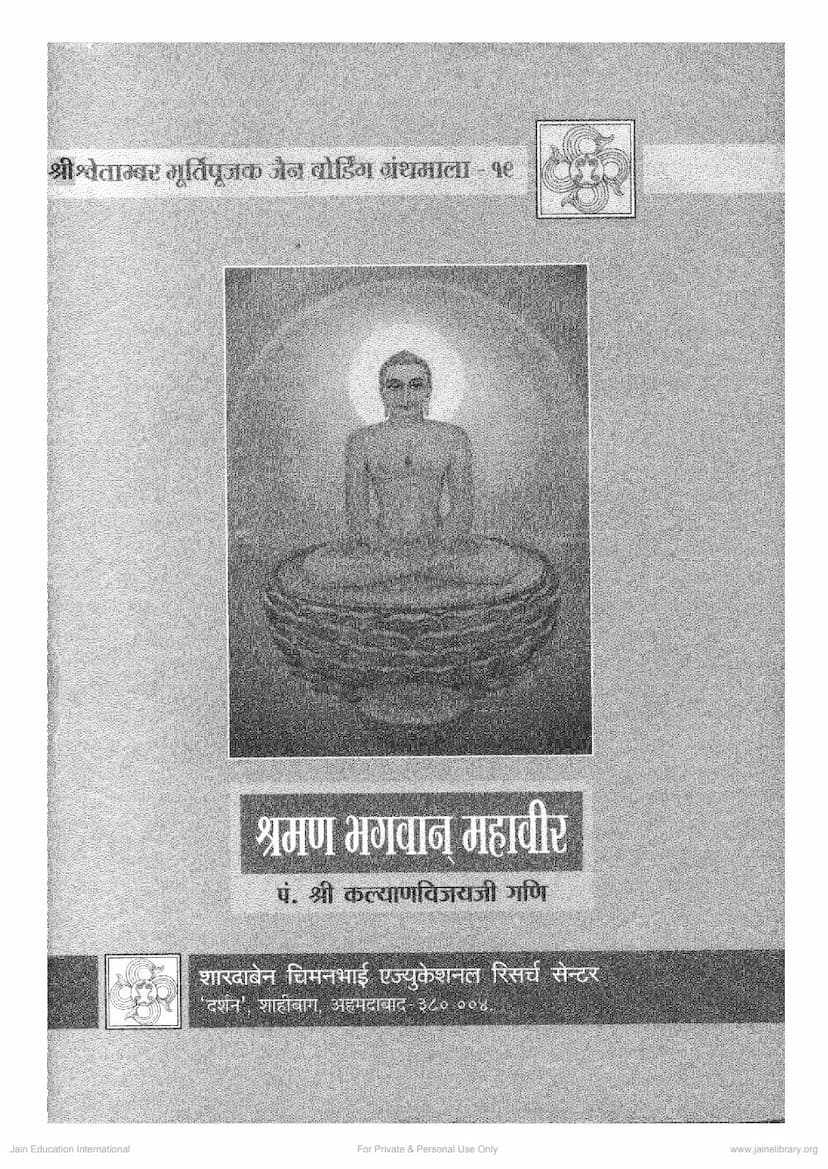Shraman Bhagvana Mahavira
Added to library: September 2, 2025

Summary
Here is a comprehensive summary of the Jain text "Shraman Bhagvana Mahavira" by Kalyanvijay Gani, based on the provided pages:
Book Title: Shraman Bhagvana Mahavira Author: Pandit Shri Kalyanvijayji Gani Publisher: Sharadaben Chimanbhai Educational Research Centre (SCERC) Series: Shri Shwetambar Murtipujak Jain Boarding Granthmala: 19 Publication Date: First Edition, February 2002
Overall Theme and Purpose:
This book is a scholarly and comprehensive biography of Bhagwan Mahavira, the 24th Jain Tirthankara. It aims to present a detailed and historically accurate account of his life, teachings, and the spread of his philosophy. The publication is dedicated to the 2600th birth anniversary of Bhagwan Mahavir, emphasizing the significance of his life and message for contemporary times. The author, Pandit Kalyanvijayji Gani, is recognized as a profound historian and an accomplished scholar of Jain Agamas.
Key Aspects and Content:
-
Author's Expertise: The preface highlights Pandit Kalyanvijayji Gani's extensive research and deep understanding of Jain scriptures and history. He is credited with compiling scattered information from Agamic literature and presenting an unparalleled account of Mahavira's life, including lesser-known events. His work on the epoch of Mahavira's Nirvana is also mentioned as a testament to his scholarly rigor.
-
In-depth Life History: The book meticulously chronicles Bhagwan Mahavira's life, starting from his birth in the Kshatriya lineage. It covers:
- Birth and Early Life: Details the auspicious circumstances of his birth, the dreams of his mother, his naming as Vardhaman (meaning 'prosperous' due to the prosperity that followed his birth), and his childhood, including anecdotes that showcase his divine nature and strength (like the incident with the serpent during the Amalaki game, which earned him the epithet 'Mahavira'). It also touches upon his education and the worldly experiences he gained, which contributed to his detachment.
- Ascetic Life (Tapasya): This section details the rigorous ascetic practices Mahavira undertook after renouncing worldly life at the age of 28. It describes his severe penances, prolonged fasts (including ṣaṇmāsika, chaturmāsika, and other forms of upavasa), enduring hardships, and facing numerous obstacles and mental/physical tortures inflicted by deities and hostile individuals. The narrative emphasizes his unwavering commitment to non-violence and self-control amidst these challenges.
- Kevali-Jivan (Life after Omniscience): This is a significant focus of the book, as Agamic literature often lacks detailed accounts of the period after Mahavira attained omniscience. The author has meticulously reconstructed this phase, year by year, detailing his travels (vihar), rainy season retreats (varshavas), sermons (samavasaran), and the spiritual awakening of numerous individuals. This section highlights his extensive preaching across various kingdoms and cities of ancient India, his philosophical dialogues, and the establishment of the four-fold Jain order (monks, nuns, laymen, and laywomen).
- Key Teachings: Beyond the biography, the book aims to present Mahavira's fundamental teachings, encapsulating the essence of Jain philosophy.
- Viharasthala-Nam-Kosh (Vihara Place Name Glossary): A substantial part of the book is dedicated to a detailed listing and explanation of the places Bhagwan Mahavira visited during his life and teachings, providing geographical and historical context.
-
Scholarly Approach:
- Agamic and Textual Basis: The author relies heavily on Jain Agamas, Niyuktis, Bhasyas, Churnis, and commentaries to reconstruct Mahavira's life.
- Historical and Geographical Context: The book attempts to place Mahavira's life within its historical and geographical milieu, referencing ancient Indian kingdoms, social conditions, and geographical locations.
- Critical Analysis: The author engages in critical analysis, especially regarding the inconsistencies and gaps in existing literature concerning Mahavira's life after omniscience. He also addresses the debates surrounding certain aspects of Jain history and tradition, such as the birthplace and the details of Mahavira's life, drawing conclusions based on his research.
- Re-publication: The re-printing of this book is noted as timely, coinciding with the 2600th birth anniversary of Mahavira, making valuable information accessible to a new generation of scholars and seekers.
-
Structure and Content Breakdown:
- Prakarana (Chapters): The book appears to be divided into sections detailing his life as a householder (Grihastha Jivan), his life as an ascetic (Tapasvi Jivan), and his life as a Tirthankara (Tirthankar Jivan).
- Detailed Year-wise Account: The section on his Kevali-Jivan provides a year-by-year account of his movements and activities, which is a remarkable feat of historical reconstruction.
- Appendices and Supporting Material: The inclusion of a glossary of Vihara places (Viharasthala-Nam-Kosh) and discussions on key disciples (Shishya Sampada), teachings (Pravachan), and previous births (Purva-bhav) enrich the scholarly value of the work.
- Addressing Controversies: The author also addresses specific points of debate, such as the traditional versus scholarly views on Mahavira's birthplace and the circumstances of his Kevalgyan, and critically examines the role of Siddharth Vyantar.
-
Legacy and Contribution:
- Reference Work: "Shraman Bhagvana Mahavira" is considered a valuable reference book for anyone studying Bhagwan Mahavira and Jainism.
- Preservation: The re-publication ensures that the scholarly work of Pandit Kalyanvijayji Gani is preserved and made accessible, especially given that the original edition had become unavailable.
- Author's Commitment: The book reflects the author's dedication to illuminating the life and teachings of the Tirthankara for the benefit of the Jain community and the wider world.
In essence, "Shraman Bhagvana Mahavira" by Kalyanvijay Gani is a monumental work that synthesizes scriptural knowledge with historical and literary research to provide an authoritative and detailed account of the life and mission of Bhagwan Mahavira, making it an indispensable resource for understanding Jainism's foundational figure.